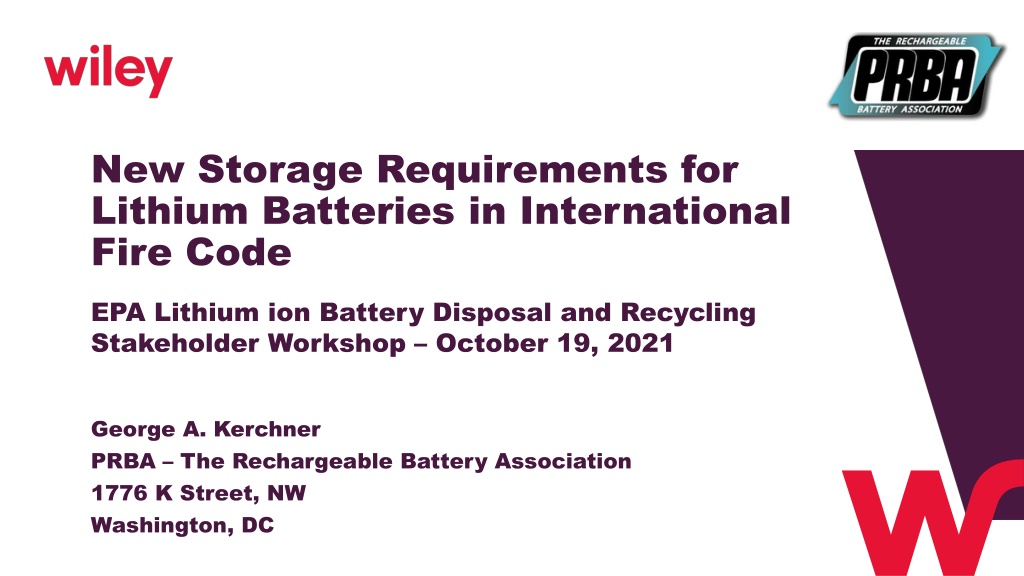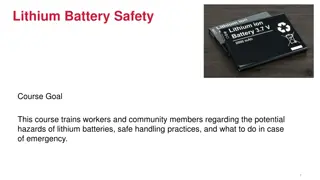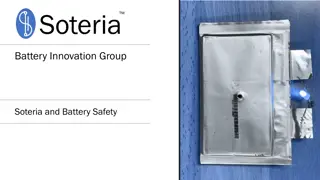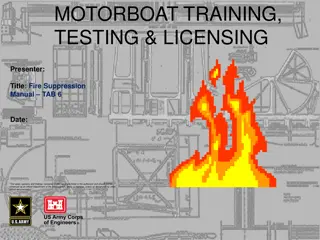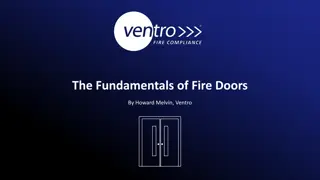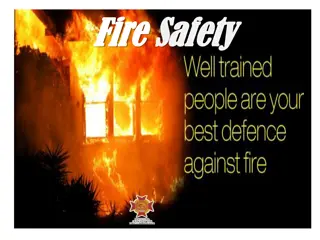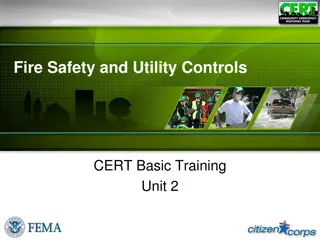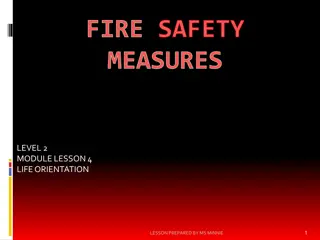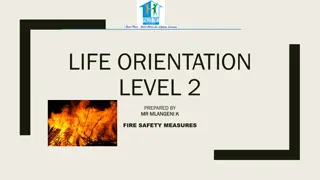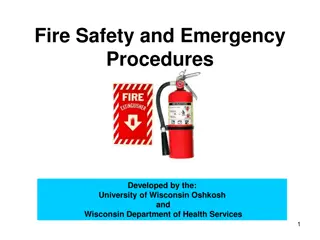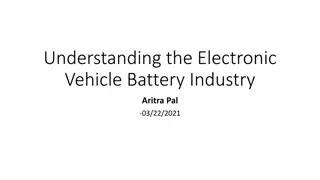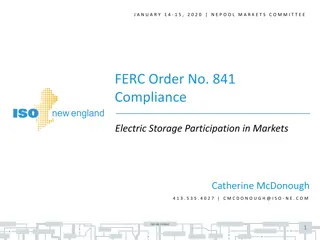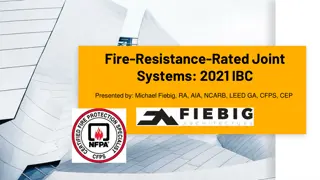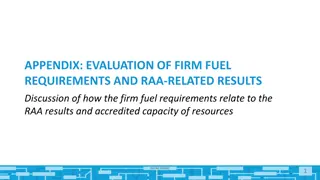New Storage Requirements for Lithium Batteries in International Fire Code
The International Fire Code (IFC) is being amended to include new storage requirements for lithium batteries due to their high hazard classification. The upcoming 2024 IFC will introduce stricter guidelines for storing lithium batteries, with limitations on indoor and outdoor storage, permit requirements, and fire safety plans. Exceptions exist for batteries used in equipment, retail packaging under certain capacities, and temporary storage during manufacturing processes. Specific regulations dictate the maximum quantities, container specifications, and location restrictions for indoor storage of lithium batteries.
Download Presentation

Please find below an Image/Link to download the presentation.
The content on the website is provided AS IS for your information and personal use only. It may not be sold, licensed, or shared on other websites without obtaining consent from the author. Download presentation by click this link. If you encounter any issues during the download, it is possible that the publisher has removed the file from their server.
E N D
Presentation Transcript
New Storage Requirements for Lithium Batteries in International Fire Code EPA Lithium ion Battery Disposal and Recycling Stakeholder Workshop October 19, 2021 George A. Kerchner PRBA The Rechargeable Battery Association 1776 K Street, NW Washington, DC
I-Codes and International Fire Code International Code Council is responsible for publication of I-Codes (e.g., International Fire Code, International Building Code) The IFC is amended every three years and adopted at the state and local levels 2021 IFC generally silent on storage requirements associated with lithium batteries Lithium ion batteries currently listed as high hazard commodity Amendments to IFC recently adopted by ICC for incorporation into 2024 IFC will place new storage requirements on lithium batteries 2
New Section 321 in Chapter 3 of IFC Section 321.1 General (include list of exceptions) 321.2 Permits 321.3 Fire Safety Plan 321.4 Storage Requirements 321.4.1 Limited Indoor Storage in Containers 321.4.2 Indoor Storage Areas 321.4.3 Outdoor Storage 3
Exceptions to New Storage Requirements New Section 321 would be generally applicable to any facilities storing or collecting lithium batteries Five exceptions found in Section 321.1 1. Batteries installed in the equipment, devices, or vehicles they are designed to power. 2. Batteries packed for use with the equipment, devices, or vehicles they are designed to power. 3. Batteries in original retail packaging that are rated at 300 watt-hours or less for lithium-ion batteries or contain 25 grams or less of lithium metal for lithium metal batteries. 4. Temporary storage of batteries or battery components during the battery manufacturing process prior to completion of final quality control checks. 5. Temporary storage of batteries during the vehicle manufacturing or repair process. 4
"Limited Indoor Storage in Containers Quantities may not exceed 15 cubic feet (approx. two 55 gallon drums) No permit required Requires fire safety plan Containers Must be open-top and noncombustible or approved for battery collection Each container and groups of containers may not exceed 7.5 cubic feet Second container or group of containers must be separated by not less than 3 feet of open space, or 10 feet of space that contains combustible materials Must be located not less than 5 feet from exits or exit access doors 5
Indoor Storage Areas Not Meeting Limited Storage Requirements Applies to indoor storage with more than 15 cubic feet of lithium batteries 1. Must secure permit and have fire safety plan 2. Technical opinion and report must be prepared to evaluate level of hazard and protection measures 6
Indoor Storage Areas Not Meeting Limited Storage Requirements 3. Construction requirements. Battery storage areas must be separated by 2-hour rated fire barriers or horizontal assemblies Exceptions: Prefabricated portable structure building with 2-hour rated fire- resistance rated enclosure If battery storage is limited to new batteries in packaging that has been demonstrated to and approved by fire code official as sufficient to isolate a fire in packaging 7
Indoor Storage Areas Not Meeting Limited Storage Requirements 4. Fire Protection System. Must be protected with automatic sprinkler system or approved alternative suppression system 5. Fire Alarm System. Must be protected with fire detection system fire using air aspirating smoke detection, radiant energy-sensing fire detection, or both 6. Explosion Control. If applicable, and in accordance with technical report 8
Indoor Storage Areas Not Meeting Limited Storage Requirements 7. Section 321.4.2.6 provides reduced requirements if batteries are stored at no more than 30% state of charge Technical report NOT required 2-hour rated fire barriers NOT required Must have procedure to verify SOC Fire sprinkler system IS required Fire detection system IS required 9
Outdoor Storage Areas Storage areas Separated by not less than 20 feet to buildings, property lines and streets Separated by not less than 3 feet to buildings, property lines and streets if protected with free-standing 2-hour fire-resistant rated assembly Separated by not less than 3 feet to buildings, property lines and streets if in portable prefabricated building with 2-hour fire- resistant rated enclosure Fire detection system required, including for portable prefabricated buildings 10
Outdoor Storage Areas Storage Area and Size Limits Shall not exceed 10 feet in height Shall not exceed 900 sq. ft. Multiple storage areas must be separated by 10 feet 11
Additional Changes to IFC and International Building Code New Section 321 in Chapter 3 of IFC also triggered additional changes to IFC and International Building Code (IBC) Chapter 1, Section 105 Operational permit (IFC) Chapter 3, Section 304 Occupancy classifications (IBC) Chapter 4, Section 403 Fire safety plans (IFC) Chapter 9, Sections 903, 907 Automatic sprinkler systems, fire alarm and detection systems (IFC & IBC) 12
Powered Micromobility Devices Powered Micromobility Devices include motorized bicycles, motorized scooters and other personal mobility devices powered by lithium batteries Prohibits use of residential dwelling as business for charging of commercially owned devices for sale or rent Mandatory UL listings for devices, chargers, batteries Battery charging areas/rooms Requires all charging devices to be plugged directly into outlet Separation of 18 inches between batteries while charging unless separated by approved fire-resistant material Fire alarm system required Fire safety and evacuation plans required 13
PRBA PRBA The Rechargeable Battery Association The Rechargeable Battery Association Established in 1991, members include: Primary and secondary cell/battery manufacturers, and battery recyclers Manufacturers of electronic equipment, medical devices, power tools, automobiles Retailers, testing labs Airlines, dangerous goods consultants, packaging manufacturers Focus on regulatory, legislative, and policy issues at state, national and international level Safety, state and federal battery recycling legislation, transportation, fire codes International transportation forums UN Sub-Committee of Experts ICAO Dangerous Goods Panel IMO Sub-Committee on Carriage of Cargoes and Containers 14
